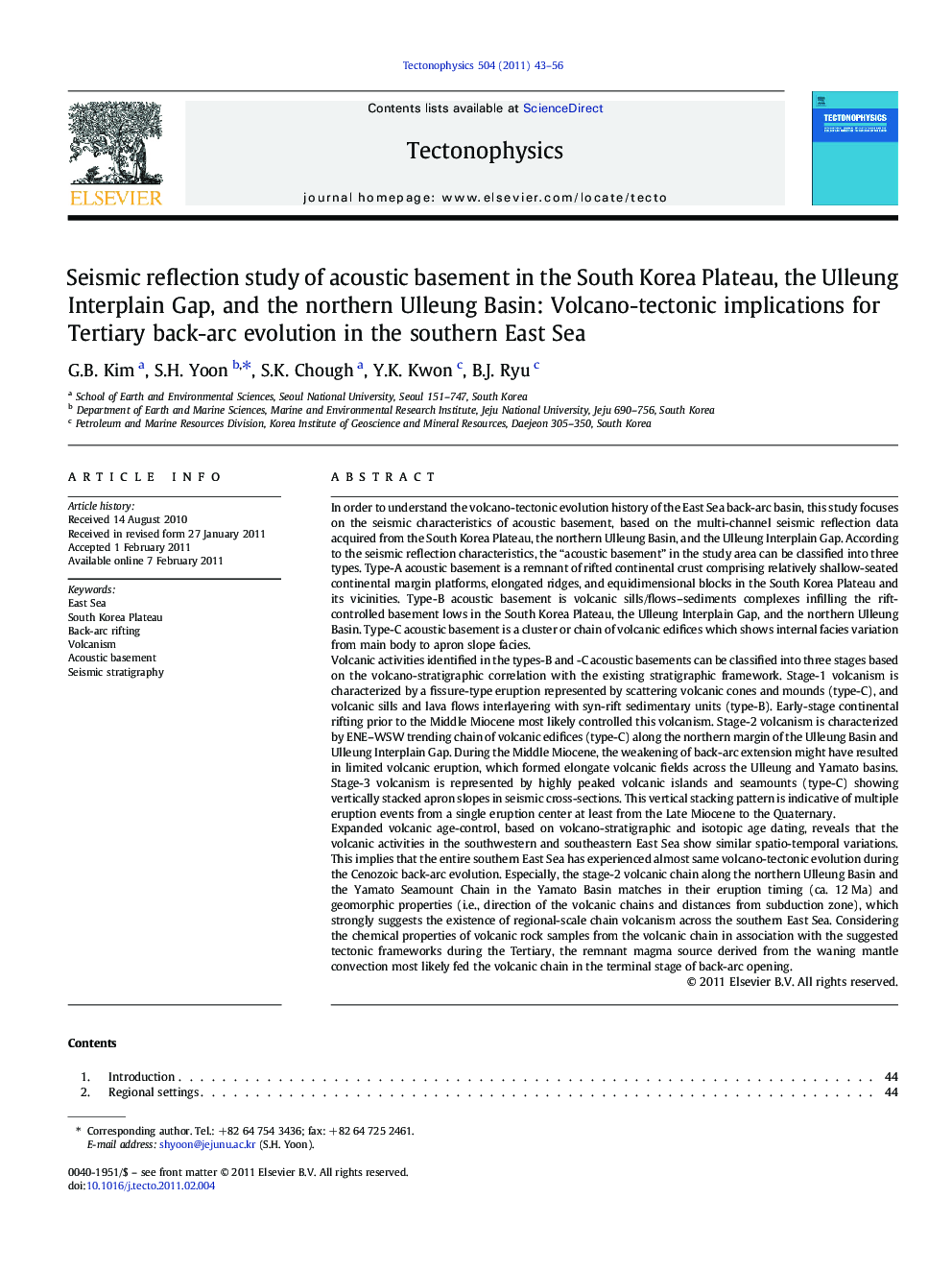| کد مقاله | کد نشریه | سال انتشار | مقاله انگلیسی | نسخه تمام متن |
|---|---|---|---|---|
| 4693176 | 1636845 | 2011 | 14 صفحه PDF | دانلود رایگان |

In order to understand the volcano-tectonic evolution history of the East Sea back-arc basin, this study focuses on the seismic characteristics of acoustic basement, based on the multi-channel seismic reflection data acquired from the South Korea Plateau, the northern Ulleung Basin, and the Ulleung Interplain Gap. According to the seismic reflection characteristics, the “acoustic basement” in the study area can be classified into three types. Type-A acoustic basement is a remnant of rifted continental crust comprising relatively shallow-seated continental margin platforms, elongated ridges, and equidimensional blocks in the South Korea Plateau and its vicinities. Type-B acoustic basement is volcanic sills/flows–sediments complexes infilling the rift-controlled basement lows in the South Korea Plateau, the Ulleung Interplain Gap, and the northern Ulleung Basin. Type-C acoustic basement is a cluster or chain of volcanic edifices which shows internal facies variation from main body to apron slope facies.Volcanic activities identified in the types-B and -C acoustic basements can be classified into three stages based on the volcano-stratigraphic correlation with the existing stratigraphic framework. Stage-1 volcanism is characterized by a fissure-type eruption represented by scattering volcanic cones and mounds (type-C), and volcanic sills and lava flows interlayering with syn-rift sedimentary units (type-B). Early-stage continental rifting prior to the Middle Miocene most likely controlled this volcanism. Stage-2 volcanism is characterized by ENE–WSW trending chain of volcanic edifices (type-C) along the northern margin of the Ulleung Basin and Ulleung Interplain Gap. During the Middle Miocene, the weakening of back-arc extension might have resulted in limited volcanic eruption, which formed elongate volcanic fields across the Ulleung and Yamato basins. Stage-3 volcanism is represented by highly peaked volcanic islands and seamounts (type-C) showing vertically stacked apron slopes in seismic cross-sections. This vertical stacking pattern is indicative of multiple eruption events from a single eruption center at least from the Late Miocene to the Quaternary.Expanded volcanic age-control, based on volcano-stratigraphic and isotopic age dating, reveals that the volcanic activities in the southwestern and southeastern East Sea show similar spatio-temporal variations. This implies that the entire southern East Sea has experienced almost same volcano-tectonic evolution during the Cenozoic back-arc evolution. Especially, the stage-2 volcanic chain along the northern Ulleung Basin and the Yamato Seamount Chain in the Yamato Basin matches in their eruption timing (ca. 12 Ma) and geomorphic properties (i.e., direction of the volcanic chains and distances from subduction zone), which strongly suggests the existence of regional-scale chain volcanism across the southern East Sea. Considering the chemical properties of volcanic rock samples from the volcanic chain in association with the suggested tectonic frameworks during the Tertiary, the remnant magma source derived from the waning mantle convection most likely fed the volcanic chain in the terminal stage of back-arc opening.
Research Highlights
► Three types of acoustic basements are newly defined in the mid-western East Sea.
► Three stages of volcanic events are newly defined in the mid-western East Sea.
► Volcano-tectonic settings appear consistent in the southern East Sea.
► Stage-2 volcanism and Yamato Seamount Chain have the same magmatic origin.
► Post-rift magmatism formed volcanic chain across the southern East Sea.
Journal: Tectonophysics - Volume 504, Issues 1–4, 9 May 2011, Pages 43–56